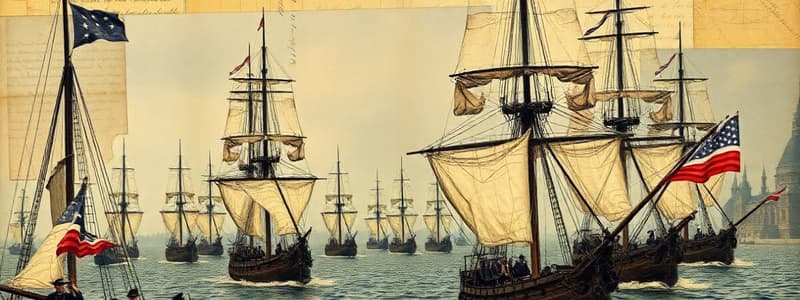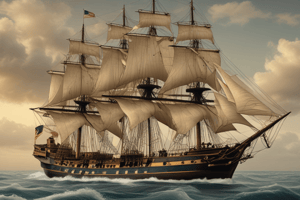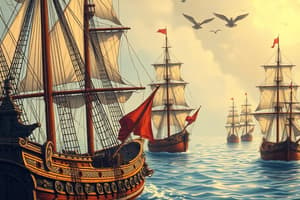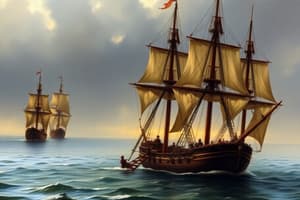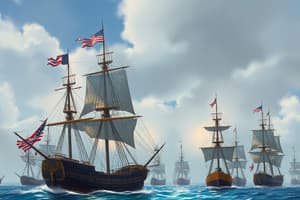Podcast
Questions and Answers
What was a significant challenge faced by the Continental Navy at the beginning of the American Revolution?
What was a significant challenge faced by the Continental Navy at the beginning of the American Revolution?
- Superior ship design compared to the British Royal Navy.
- Unwavering support from all thirteen colonies.
- An abundance of experienced naval officers ready to command.
- Inadequate training and lack of discipline among sailors and marines. (correct)
What was the primary effect of American privateers on the British during the American Revolution?
What was the primary effect of American privateers on the British during the American Revolution?
- They had minimal impact due to their small numbers and lack of coordination.
- They directly engaged and defeated the majority of the Royal Navy warships.
- They forced the British to completely abandon naval operations in American waters.
- They significantly disrupted British commerce, leading to increased insurance rates and economic pressure. (correct)
Why were Benedict Arnold's naval battles on Lake Champlain strategically important, despite his losses?
Why were Benedict Arnold's naval battles on Lake Champlain strategically important, despite his losses?
- They directly led to the capture of Fort Ticonderoga by American forces.
- They demonstrated the superior naval technology of the American fleet.
- They secured control of the Great Lakes for the Americans throughout the war.
- They forced the British to divert resources and delay their advance, impacting the campaign toward Saratoga. (correct)
How did the entrance of France, Spain, and the Netherlands into the American Revolution affect the naval conflict?
How did the entrance of France, Spain, and the Netherlands into the American Revolution affect the naval conflict?
What was the strategic outcome of the Battle of Virginia Capes in September 1781?
What was the strategic outcome of the Battle of Virginia Capes in September 1781?
What role did Esek Hopkins play in the early stages of the American Revolution?
What role did Esek Hopkins play in the early stages of the American Revolution?
How did the attacks by American privateers contribute to the rising unrest within Britain towards the end of the American Revolution?
How did the attacks by American privateers contribute to the rising unrest within Britain towards the end of the American Revolution?
What impact did shortages in modern Royal Navy vessels and equipment have on the British naval strategy during the American Revolution?
What impact did shortages in modern Royal Navy vessels and equipment have on the British naval strategy during the American Revolution?
How did George Rodney's decisions in the West Indies in 1781 impact the strategic situation in the American colonies?
How did George Rodney's decisions in the West Indies in 1781 impact the strategic situation in the American colonies?
How did the experience of the colonies' merchant service contribute to the early naval efforts during the American Revolution?
How did the experience of the colonies' merchant service contribute to the early naval efforts during the American Revolution?
Flashcards
Continental Navy
Continental Navy
Authorized on October 13, 1775, it consisted of 27 warships by 1776.
Privateering
Privateering
Naval warfare tactic where privately owned ships were authorized to attack enemy vessels.
Battle of Yorktown
Battle of Yorktown
Victory in 1781 that secured American Independence.
Naval Documents of the American Revolution Series
Naval Documents of the American Revolution Series
Signup and view all the flashcards
John Paul Jones
John Paul Jones
Signup and view all the flashcards
Battle of the Chesapeake
Battle of the Chesapeake
Signup and view all the flashcards
Esek Hopkins' fleet attacks
Esek Hopkins' fleet attacks
Signup and view all the flashcards
Study Notes
American Revolution Overview
- Lasted from 1775 to 1783
- Illustration depicts the battle between the Continental Navy ship Bonhomme Richard and HMS Serapis on Sept 23, 1779
- The original painting is by Thomas Mitchell
Naval Forces Before the Revolution
- Original 13 colonies primarily had merchant vessels engaged in trade
- Colonists had experience with the sea and warfare due to British naval expeditions against Cartagena, Spain, and Nova Scotia during the war with France from 1754-1763
Continental Navy Formation
- Continental Congress authorized the Continental Navy on October 13, 1775
- U.S. Marine Corps established on November 10
- By 1776, the colonies had 27 warships, while the Royal British Navy had approximately 270
- American commanders faced challenges with untrained sailors and marines with lack of discipline
Early Successes of the Continental Navy
- Esek Hopkins' fleet attacked a British colony in the Bahamas on February 17, 1776
- Captured guns, ammunition, and the governor with his lieutenant which marked the first amphibious assault
- Two British vessels were also seized
- Captains Lambert Wickes, Gustavus Conyngham, and John Barry achieved successes like John Paul Jones
- Jones, as captain of Ranger, captured British man-of-war Drake
- Jones defeated British frigate Serapis as captain of Bonhomme Richard
Impact of American Privateers
- American privateers significantly damaged British shipping
- Over 2,000 privately armed vessels were used, carrying over 18,000 guns and manned by around 70,000 men
- State navies and Continental Navy ships put naval pressure on the British
- By the end of 1777, American ships had captured over 500 British vessels, rising to about 1,500 by the war's end
- Over 12,000 British sailors were taken as prisoners of war
- British marine insurance rates increased, and coastal populations feared American and allied invasions
- By 1781, British merchants sought an end to hostilities
Key Naval Actions
- Most naval actions occurred on the open sea
- Benedict Arnold's battles on Lake Champlain on October 11, 1776, and off Split Rock, New York, were exceptions
- Arnold's fleet construction delayed the British attack on Fort Ticonderoga
- This delay impacted the British campaign leading to the 1777 Battle of Saratoga
Foreign Involvement
- France and Spain entered the war in 1779, followed by the Netherlands in 1780
- The Spanish and Dutch tied down British naval forces in Europe due to insufficient British vessels to blockade American ports
- The British capacity was stretched to the coasts of Europe, the Caribbean, and colonies in southeast and south Asia
French Support
- A French squadron landed General Marshal Jean-Baptiste Rochambeau’s army in Newport, Rhode Island
- Admiral François-Joseph-Paul de Grasse sailed for the American colonies
- Admiral Samuel Hood was dispatched north to counter De Grasse
Battle of Virginia Capes
- On September 5, 1781, the Battle of Virginia Capes (Battle of the Chesapeake) occurred
- This battle prevented the Royal Navy from reinforcing or evacuating British forces at Yorktown, Virginia
- French control of the sea lanes allowed them to supply Washington which led to the defeat of British forces under General Lord Charles Cornwallis
Securing Independence
- The American victory at Yorktown secured independence for the Colonies
- Preliminary peace articles were signed on November 30, 1782
- The Peace of Paris (September 3, 1783) officially ended the American Revolution, where Great Britain recognized the U.S. independence
Naval Documents Series
- Naval History and Heritage Command presents the first 13 volumes containing diaries, petitions, ship logs, muster rolls, orders, official reports, and newspaper accounts
- The collection includes American, British, French, and Spanish perspectives from civilians, women, slaves, policymakers, and officers
- The first volume was published in 1964 with a foreword by President John F. Kennedy
Studying That Suits You
Use AI to generate personalized quizzes and flashcards to suit your learning preferences.
